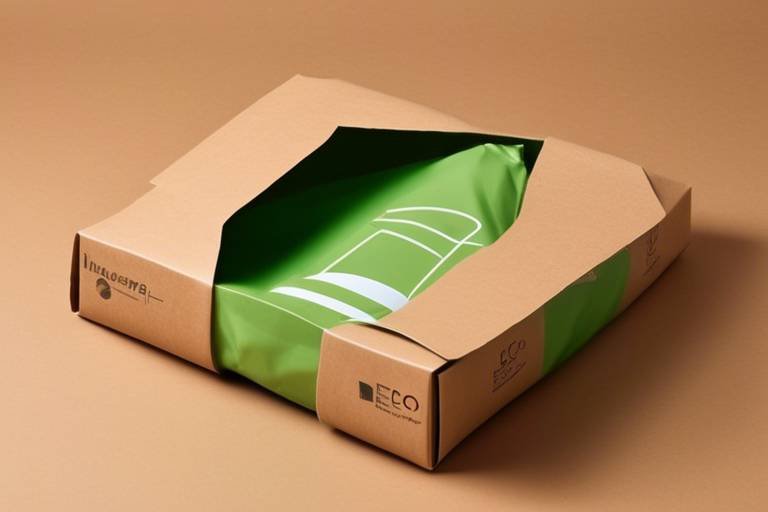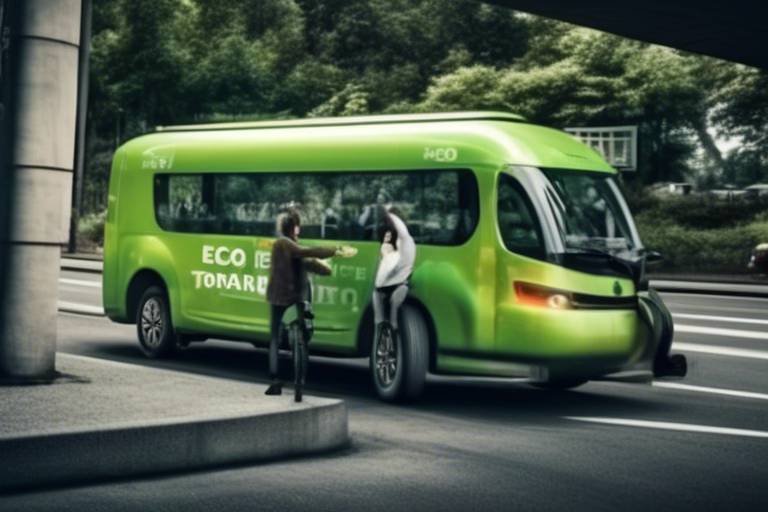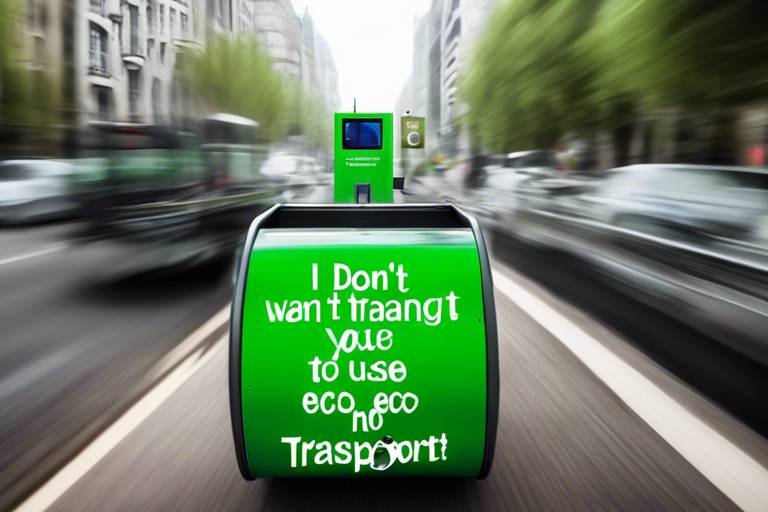The Growing Trend of Eco-Friendly Packaging in E-commerce
In today's digital marketplace, where every click and purchase counts, the packaging game is evolving rapidly. With the rise of e-commerce, there's a growing awareness about the environmental impact of packaging materials. Consumers are not just looking for products; they are also keen on how these products are packaged. This shift towards eco-friendly packaging is not just a trend; it's becoming a necessity. Imagine receiving a beautifully wrapped product only to find that the packaging contributes to the growing landfill crisis. It's a scenario that many are no longer willing to accept. As a result, businesses are stepping up their game, adopting sustainable practices that not only appeal to eco-conscious consumers but also contribute positively to the planet.
Sustainable packaging is crucial for reducing waste and minimizing environmental impact. In the e-commerce industry, where products are shipped in bulk and often discarded after a single use, the significance of sustainable packaging cannot be overstated. It plays a pivotal role in promoting sustainability by minimizing the carbon footprint associated with packaging materials. By choosing eco-friendly options, companies can significantly reduce their environmental impact while also enhancing their brand image. Think of it as a win-win situation: businesses save costs in the long run, and consumers feel good about their purchases. Furthermore, sustainable packaging often aligns with corporate social responsibility initiatives, making it a strategic choice for companies looking to improve their public perception.
As the demand for sustainable solutions grows, so does the innovation in materials used for packaging. E-commerce businesses are increasingly turning to biodegradable, compostable, and recyclable materials that not only serve their purpose but also align with environmental goals. This shift is akin to changing the engine of a car to make it more fuel-efficient; it requires investment and effort, but the long-term benefits are undeniable.
One of the most exciting developments in eco-friendly packaging is the rise of biodegradable materials. These materials break down naturally over time, significantly reducing landfill waste. For e-commerce businesses, adopting biodegradable packaging can enhance their sustainability profile. Options like plant-based plastics and paper products that decompose within months are becoming increasingly popular. Not only do they reduce waste, but they also resonate with consumers who value environmental responsibility.
Compostable materials are another fantastic eco-friendly option. Unlike traditional plastics, compostable packaging decomposes into nutrient-rich soil, providing a natural benefit to the environment. This type of packaging is particularly appealing to consumers who are keen on sustainability. For e-commerce businesses, integrating compostable materials into their packaging strategy can elevate their brand's eco-friendly image. Imagine receiving a package that not only protects your product but also contributes positively to the earth when disposed of! It’s a powerful message that resonates with today’s environmentally conscious consumers.
Recyclable packaging is a cornerstone of sustainable practices. By using materials that can be recycled, e-commerce companies can help conserve resources and reduce pollution. The importance of recyclable packaging in the e-commerce sector cannot be understated, as it encourages a circular economy where materials are reused rather than discarded. Consumers are increasingly demanding packaging that they can recycle, and businesses that meet this demand can enjoy a competitive edge. It's like being part of an exclusive club where members are committed to making the world a better place.
As consumers become more environmentally conscious, the demand for eco-friendly packaging options is skyrocketing. Today’s shoppers are not just buying products; they are making choices that reflect their values. They want to support brands that prioritize sustainability, and this shift is shaping the packaging choices in e-commerce. Companies that listen to this demand and adapt their packaging strategies accordingly can build loyalty and trust among their customers. Think of it as a relationship; when you show that you care about what matters to your partner, the bond strengthens.
While the transition to eco-friendly packaging is beneficial, it does come with its challenges. E-commerce companies often face obstacles in adopting sustainable practices that can hinder their progress. Understanding these challenges is crucial for businesses looking to make the switch.
One significant hurdle in the transition to eco-friendly packaging is the cost. Sustainable materials can sometimes be more expensive than traditional options, leading to concerns about profit margins. However, it’s essential to view this transition as an investment rather than an expense. The potential return on investment could be substantial as consumers increasingly seek out brands that align with their values. Over time, the cost of sustainable packaging can be offset by increased customer loyalty and sales.
Implementing sustainable packaging solutions requires adjustments in the supply chain. This means that e-commerce companies must collaborate with suppliers and logistics partners who share their commitment to sustainability. The logistical challenges can be daunting, but overcoming them is crucial for long-term success. By working together, stakeholders in the e-commerce industry can create a more sustainable future for all.
- What is eco-friendly packaging? Eco-friendly packaging refers to materials that are sustainable, biodegradable, compostable, or recyclable, minimizing environmental impact.
- Why is sustainable packaging important for e-commerce? It reduces waste, conserves resources, and meets consumer demand for environmentally responsible products.
- What are some examples of biodegradable materials? Plant-based plastics, paper, and certain types of biopolymers are common biodegradable materials.
- How can businesses overcome the cost of sustainable packaging? Viewing it as an investment and focusing on the long-term benefits, such as brand loyalty and customer satisfaction, can help offset initial costs.

The Importance of Sustainable Packaging
In today's world, where environmental concerns are at the forefront of global discussions, sustainable packaging has emerged as a vital aspect of the e-commerce industry. The significance of sustainable packaging cannot be overstated; it plays a crucial role in reducing waste and minimizing the overall environmental impact of consumer goods. As e-commerce continues to grow, so does the volume of packaging waste generated. This is where sustainable practices come into play, offering a solution that benefits both businesses and the planet.
Imagine opening a package delivered to your doorstep, only to find layers of plastic and non-biodegradable materials. It can be disheartening, right? Now, picture instead a box made from recycled materials, filled with biodegradable packing peanuts that can decompose without harming the environment. This shift in packaging not only enhances the unboxing experience but also reflects a commitment to sustainability. By adopting eco-friendly packaging, businesses can significantly reduce their carbon footprint and contribute to a healthier planet.
Moreover, sustainable packaging is not just about the materials used; it's also about the overall lifecycle of the product. It encourages companies to rethink their packaging strategies, leading to innovations that prioritize resource efficiency and environmental responsibility. For instance, many companies are now opting for minimalistic designs that use less material while still ensuring product safety. This approach not only cuts down on waste but also reduces shipping costs, creating a win-win situation for both the business and the consumer.
In addition to environmental benefits, sustainable packaging can enhance a brand's reputation. Consumers today are more informed and conscious of their purchasing decisions. They prefer brands that align with their values, and sustainability is a significant factor. By showcasing a commitment to eco-friendly practices, companies can attract a loyal customer base and differentiate themselves from competitors. This growing trend is evident in consumer behavior, as more shoppers are willing to pay a premium for products packaged sustainably.
Furthermore, sustainable packaging can lead to compliance with regulations and standards that are increasingly being put in place by governments worldwide. As more regions enact laws aimed at reducing plastic waste, businesses that proactively adopt eco-friendly packaging solutions will not only avoid potential penalties but also position themselves as leaders in the industry.
In summary, the importance of sustainable packaging in e-commerce extends beyond just reducing waste. It encompasses a holistic approach that benefits the environment, enhances brand loyalty, and ensures compliance with emerging regulations. As consumers continue to demand more responsible choices, businesses must recognize that sustainable packaging is not just an option, but a necessity for future growth and success.
- What is sustainable packaging? Sustainable packaging refers to packaging that is designed to have minimal impact on the environment, typically made from renewable, recyclable, or biodegradable materials.
- Why is sustainable packaging important for e-commerce? It helps reduce waste, lowers carbon footprints, enhances brand reputation, and meets consumer demand for environmentally friendly products.
- What materials are commonly used in sustainable packaging? Biodegradable, compostable, and recyclable materials are among the most popular choices for sustainable packaging solutions.
- How can businesses transition to sustainable packaging? Businesses can start by assessing their current packaging materials, exploring eco-friendly alternatives, and gradually implementing changes in their supply chain.

Innovative Materials for Eco-Friendly Packaging
This article explores the rise of eco-friendly packaging in the e-commerce sector, highlighting its benefits, innovative materials, and impact on consumer behavior and the environment.
Sustainable packaging is crucial for reducing waste and minimizing environmental impact. This section discusses its significance in the e-commerce industry and its role in promoting sustainability.
In the ever-evolving landscape of e-commerce, innovative materials are at the forefront of the shift towards eco-friendly packaging. Businesses are increasingly recognizing that the materials they use can significantly impact not just their bottom line but also the planet. Various alternatives are emerging, each with unique properties that cater to the growing demand for sustainability. This shift is not just a trend; it’s a necessity for a healthier planet.
Among the most notable materials making waves in the packaging industry are biodegradable, compostable, and recyclable options. These materials not only serve their purpose of protecting products during transit but also align with the values of environmentally conscious consumers. Let's dive deeper into these innovative materials and their benefits.
Biodegradable packaging is designed to break down naturally over time, significantly reducing landfill waste. Unlike traditional plastics, which can take hundreds of years to decompose, biodegradable options can disintegrate in a matter of months under the right conditions. This makes them a fantastic choice for e-commerce businesses looking to minimize their environmental footprint.
Some common biodegradable materials include:
- PLA (Polylactic Acid): Made from renewable resources like corn starch, PLA is widely used for packaging and is known for its ability to decompose under industrial composting conditions.
- PHA (Polyhydroxyalkanoates): Produced by microorganisms, PHA is another biodegradable alternative that can break down in various environments, including marine settings.
Compostable materials take the eco-friendly concept a step further by not only breaking down into natural substances but also enriching the soil in the process. When these materials decompose, they transform into nutrient-rich compost that can be used to nourish plants, creating a circular economy that benefits both businesses and the environment.
These materials are particularly appealing to e-commerce companies that aim to enhance their green credentials. For instance, packaging made from organic waste or plant fibers can be composted at home or in industrial facilities, making them a practical choice for eco-conscious consumers.
Recyclable packaging plays a critical role in conserving resources and reducing pollution. By choosing materials that can be recycled, e-commerce businesses contribute to a circular economy, where products are reused and repurposed rather than discarded. This not only helps in decreasing the demand for new raw materials but also minimizes the energy consumption associated with producing new packaging.
Common recyclable materials include:
- Cardboard: Widely accepted in recycling programs, cardboard is biodegradable and recyclable, making it an ideal choice for shipping.
- Glass: Not only is glass recyclable, but it is also reusable, which makes it a sustainable option for packaging beverages and other products.
The integration of recyclable materials into e-commerce packaging can significantly reduce waste and promote a more sustainable future. Companies that prioritize recyclable options not only appeal to environmentally conscious consumers but also position themselves as leaders in the industry.
As consumers become more environmentally conscious, demand for eco-friendly packaging increases. This section explores how consumer preferences are shaping packaging choices in e-commerce.
While the shift to eco-friendly packaging is beneficial, there are challenges involved. This section discusses the obstacles that e-commerce companies face in adopting sustainable practices.
The transition to eco-friendly packaging can be costly for businesses. This subsection examines the financial implications and potential return on investment for e-commerce companies.
Sustainable packaging requires adjustments in the supply chain. This section discusses the logistical challenges and the need for collaboration among stakeholders in the e-commerce industry.
Q: What is eco-friendly packaging?
A: Eco-friendly packaging refers to materials that are sustainable, biodegradable, compostable, or recyclable, minimizing environmental impact.
Q: Why is eco-friendly packaging important for e-commerce?
A: It helps reduce waste, lowers carbon footprints, and meets the growing consumer demand for sustainable products.
Q: What are some examples of eco-friendly packaging materials?
A: Common examples include biodegradable plastics, recycled cardboard, and compostable materials like plant fibers.
Q: Can eco-friendly packaging be cost-effective?
A: While initial costs may be higher, the long-term benefits, such as customer loyalty and reduced waste disposal costs, can make it financially viable.

Biodegradable Packaging Solutions
In the quest for a greener planet, have emerged as a game-changer in the e-commerce industry. Unlike traditional packaging materials that linger in landfills for centuries, biodegradable options break down naturally over time, significantly reducing the amount of waste we generate. Imagine a world where your online shopping habits do not contribute to environmental degradation—this is the promise of biodegradable packaging.
So, what exactly makes packaging biodegradable? It typically consists of materials that can decompose through natural processes, thanks to the action of microorganisms. Common biodegradable materials include cornstarch, mushroom mycelium, and paper products. These materials not only minimize waste but also offer a multitude of benefits for e-commerce businesses. For instance, using biodegradable packaging can enhance a brand's image, appealing to eco-conscious consumers who are more likely to support companies that prioritize sustainability.
Furthermore, biodegradable packaging can also lead to cost savings in the long run. Although the initial investment might be higher compared to conventional materials, the positive impact on brand loyalty and customer satisfaction can yield significant returns. A recent study showed that over 70% of consumers are willing to pay more for products packaged sustainably. This statistic highlights the growing trend where consumers are not just looking for quality products, but also for brands that align with their values.
However, it’s essential to understand that not all biodegradable packaging is created equal. Some products may require specific conditions to decompose effectively, such as industrial composting facilities, which are not always accessible. Therefore, e-commerce businesses must ensure that their chosen biodegradable materials are suitable for their logistics and customer base.
In summary, adopting biodegradable packaging solutions is not just a trend; it's a necessary shift towards a more sustainable future. By choosing biodegradable options, e-commerce companies can significantly reduce their environmental footprint while simultaneously appealing to a growing demographic of eco-conscious consumers. The future of packaging is here, and it’s time to embrace it!
- What is biodegradable packaging? Biodegradable packaging is made from materials that can decompose naturally over time, reducing landfill waste.
- How long does it take for biodegradable packaging to break down? The breakdown time can vary depending on the material and environmental conditions, but it typically ranges from a few months to a couple of years.
- Can biodegradable packaging be recycled? Some biodegradable materials can be recycled, but it's essential to check local recycling guidelines to ensure proper disposal.
- Why should businesses switch to biodegradable packaging? Switching to biodegradable packaging can enhance brand reputation, attract environmentally conscious consumers, and contribute to sustainability efforts.

Compostable Materials: A Greener Option
When it comes to sustainable packaging, compostable materials stand out as a shining example of innovation and environmental responsibility. Unlike traditional plastics that can take hundreds of years to decompose, compostable materials break down into nutrient-rich soil within a matter of months, making them an invaluable option for e-commerce businesses looking to reduce their ecological footprint. Imagine sending a package that not only protects its contents but also contributes positively to the environment once it’s discarded. Sounds like a win-win, right?
Compostable materials are typically made from natural substances such as cornstarch, sugarcane, and other plant-based materials. These organic compounds are designed to decompose under specific conditions, transforming into compost that can nourish the earth. This process not only helps to divert waste from landfills but also enriches the soil, promoting a healthier ecosystem. For e-commerce companies, incorporating compostable packaging is not just about being trendy; it’s about making a tangible impact on sustainability.
One of the significant advantages of compostable materials is their versatility. They can be used for various packaging types, including:
- Mailers: Lightweight and durable, perfect for shipping clothing and other soft goods.
- Food Packaging: Ideal for restaurants and food delivery services, ensuring that food waste can be composted.
- Shipping Boxes: Sturdy enough to protect products during transit while being completely compostable.
However, it’s essential to note that compostable materials require specific conditions to break down effectively. They typically need to be processed in industrial composting facilities that maintain the right temperature and moisture levels. This means that while they are an excellent option for reducing waste, consumers must be educated about proper disposal methods. E-commerce companies can play a crucial role in this by providing clear instructions on how to compost their packaging materials.
In summary, compostable materials represent a greener option for e-commerce packaging, offering a practical solution to environmental challenges. By choosing compostable options, businesses not only meet the growing consumer demand for sustainability but also contribute to a circular economy where waste is minimized, and resources are replenished. As the world continues to grapple with the consequences of plastic pollution, embracing compostable materials could be the key to a more sustainable future.
1. What are compostable materials?
Compostable materials are organic substances that can break down into nutrient-rich compost under specific conditions, typically within a few months. They are made from natural sources like cornstarch and sugarcane.
2. How do compostable materials differ from biodegradable materials?
While all compostable materials are biodegradable, not all biodegradable materials are compostable. Compostable materials require specific conditions to break down, whereas biodegradable materials may decompose at varying rates and not necessarily enrich the soil.
3. Can compostable packaging be recycled?
No, compostable packaging should not be recycled. It is designed to decompose in composting facilities and can contaminate recycling streams if mixed with recyclable materials.
4. How can I properly dispose of compostable packaging?
To properly dispose of compostable packaging, you should check if there are local composting facilities or programs in your area. If not, consider starting a home composting system.

Recyclable Packaging and Its Benefits
In today's world, where environmental concerns are at the forefront of many discussions, recyclable packaging stands out as a beacon of hope for both businesses and consumers. The benefits of using recyclable materials in e-commerce packaging are profound, not just for the environment, but also for the companies that adopt these practices. Imagine a world where every package you receive could be transformed into something new rather than ending up in a landfill. That's the power of recyclable packaging!
One of the primary advantages of using recyclable packaging is its ability to conserve natural resources. When materials like paper, cardboard, and certain plastics are recycled, they can be reprocessed into new products, reducing the need for virgin materials. This not only saves trees and reduces energy consumption but also helps to lower greenhouse gas emissions. It’s like giving Mother Nature a much-needed break!
Furthermore, incorporating recyclable packaging can significantly enhance a brand's image. As consumers become more environmentally conscious, they are more likely to support brands that demonstrate a commitment to sustainability. A recent study revealed that over 70% of consumers are willing to pay a premium for products packaged in eco-friendly materials. This shift in consumer behavior means that businesses adopting recyclable packaging can tap into a growing market of eco-aware shoppers.
However, it’s essential to note that not all recyclable materials are created equal. For instance, packaging must be labeled correctly to ensure that consumers understand how to dispose of it properly. A clear recycling symbol can guide consumers, ensuring that the packaging is returned to the recycling stream rather than ending up in the trash. This is where education and awareness play a critical role in the effectiveness of recyclable packaging.
Moreover, the economic implications cannot be overlooked. While some businesses may perceive the transition to recyclable packaging as an additional cost, the long-term savings can be substantial. By reducing waste disposal fees and potentially benefiting from tax incentives for sustainable practices, companies can see a positive return on investment. It’s a classic case of spending a little more now to save a lot later!
Lastly, the impact of recyclable packaging extends beyond just the immediate benefits. It contributes to a circular economy, where products are designed with their end-of-life in mind, promoting sustainability at every stage of the product lifecycle. This approach not only reduces waste but also fosters innovation as businesses explore new ways to create recyclable materials and packaging solutions.
In summary, the adoption of recyclable packaging is a win-win for both the environment and businesses. By conserving resources, enhancing brand image, and paving the way for a circular economy, recyclable packaging is more than just a trend; it's a necessary shift towards a more sustainable future.
- What types of materials can be recycled? Common recyclable materials include paper, cardboard, glass, and certain plastics. Always check local recycling guidelines for specifics.
- How can businesses ensure their packaging is recyclable? Businesses should look for materials with clear recycling symbols and work with suppliers who prioritize sustainable practices.
- What are the environmental benefits of using recyclable packaging? It conserves natural resources, reduces landfill waste, and lowers greenhouse gas emissions.
- Can consumers influence the shift towards recyclable packaging? Absolutely! Consumer demand for sustainable options encourages businesses to adopt eco-friendly practices.

Consumer Demand for Eco-Friendly Options
In today's fast-paced world, where convenience often trumps sustainability, an interesting shift is happening in consumer behavior. More and more people are becoming aware of their environmental footprint, leading to a growing demand for eco-friendly packaging options in the e-commerce sector. It's as if consumers have taken off their blindfolds and are now keenly aware of the impact their choices have on the planet. Have you ever stopped to think about how the packaging of your online orders contributes to waste? Well, you're not alone!
Recent surveys indicate that a significant percentage of consumers are willing to pay a premium for products that come in sustainable packaging. In fact, studies show that approximately 70% of shoppers prefer brands that use environmentally friendly packaging. This trend is not just a passing fad; it reflects a deeper societal shift towards sustainability. As consumers become more educated about the environmental issues at hand, they are making conscious choices that align with their values.
But what exactly is driving this demand? For one, the rise of social media has amplified awareness of environmental issues. Consumers are sharing their concerns and experiences, creating a community that values sustainability. Additionally, brands that embrace eco-friendly practices are often rewarded with increased loyalty and trust from their customers. It's a win-win situation: consumers feel good about their purchases, and brands gain a competitive edge.
Moreover, the younger generation, particularly millennials and Gen Z, is leading the charge for sustainable practices. They are not just passive consumers; they actively seek out brands that reflect their values. This demographic is more inclined to support businesses that prioritize the environment, making it crucial for e-commerce companies to adapt to these changing preferences. In fact, a study by Nielsen revealed that 73% of millennials are willing to spend more on sustainable products. It's clear that the demand for eco-friendly options is not just a trend; it's becoming the norm.
As companies respond to this demand, they are finding innovative ways to incorporate sustainable packaging into their operations. From biodegradable mailers to recycled cardboard boxes, the options are expanding rapidly. An interesting aspect of this shift is that consumers are also becoming more knowledgeable about what constitutes sustainable packaging. They are looking for materials that are not only recyclable but also made from renewable resources. This informed consumer base is pushing companies to be more transparent about their packaging choices.
In conclusion, the demand for eco-friendly packaging in e-commerce is a reflection of a broader movement towards sustainability. Consumers are not just passive recipients of products; they are active participants in a narrative that prioritizes the health of our planet. As this trend continues to grow, e-commerce businesses must adapt or risk being left behind. The question now is, how will your favorite brands respond to this call for change?
- Why is eco-friendly packaging important?
Eco-friendly packaging helps reduce waste, conserves resources, and minimizes environmental impact, making it essential for sustainable business practices. - What materials are commonly used in eco-friendly packaging?
Common materials include biodegradable plastics, recycled paper, and compostable materials that break down naturally. - How can consumers identify eco-friendly packaging?
Look for certifications and labels indicating that the packaging is recyclable, biodegradable, or made from sustainable materials. - Are eco-friendly packaging options more expensive?
While some sustainable options may have a higher upfront cost, they can lead to long-term savings by reducing waste and improving brand loyalty.

Challenges in Adopting Eco-Friendly Packaging
While the transition to eco-friendly packaging is undoubtedly a step in the right direction for the environment, it doesn't come without its challenges. E-commerce companies often find themselves navigating a complex landscape filled with obstacles that can deter them from fully embracing sustainable practices. One of the primary issues is the cost implications associated with sourcing and implementing eco-friendly materials. Unlike traditional packaging, which is often cheaper and more readily available, sustainable options can carry a higher price tag. This can be particularly daunting for small businesses that operate on tight budgets and may not have the financial flexibility to absorb these additional costs.
Moreover, the logistical challenges tied to eco-friendly packaging cannot be overlooked. Companies need to rethink their entire supply chain, which involves coordinating with suppliers who can provide sustainable materials, adjusting production processes, and possibly even re-evaluating their distribution methods. This requires a level of collaboration that many businesses may not be prepared for, leading to delays and inefficiencies. The need for a seamless integration of sustainable practices into existing operations can be a significant hurdle, especially for those who have been using conventional packaging for years.
Additionally, there is often a lack of awareness among consumers regarding the benefits of eco-friendly packaging. While many people express a desire to support sustainable practices, their purchasing decisions may not always reflect this. E-commerce businesses might find themselves in a predicament where they invest in eco-friendly options, only to see minimal return on that investment due to a lack of consumer demand or understanding. This disconnect can create a sense of frustration for companies striving to do the right thing but not seeing the desired impact on their sales.
Despite these challenges, the push towards sustainable packaging is gaining momentum. Companies that successfully navigate these obstacles can reap significant rewards, not just in terms of environmental impact but also in enhancing their brand image and customer loyalty. To better understand the challenges, let’s take a closer look at some of the key factors that e-commerce businesses must consider:
| Challenge | Description |
|---|---|
| Cost Implications | Higher initial investment for sustainable materials compared to traditional options. |
| Logistical Challenges | Need for supply chain adjustments and collaboration with sustainable suppliers. |
| Lack of Consumer Awareness | Consumers may not fully understand or prioritize eco-friendly packaging in their purchasing decisions. |
In conclusion, while the journey towards adopting eco-friendly packaging is fraught with challenges, it is also filled with opportunities for innovation and growth. By overcoming these hurdles, e-commerce companies can not only contribute to a healthier planet but also position themselves as leaders in sustainability, potentially attracting a loyal customer base that values environmentally conscious practices.
- What are the main challenges in adopting eco-friendly packaging? The main challenges include cost implications, logistical adjustments, and a lack of consumer awareness.
- Is eco-friendly packaging more expensive than traditional packaging? Generally, yes. Eco-friendly materials often come at a higher price point, which can be a barrier for some businesses.
- How can companies overcome the logistical challenges of sustainable packaging? Companies can collaborate with suppliers, invest in training, and streamline their supply chain processes to integrate sustainable practices effectively.
- What impact does consumer awareness have on the adoption of eco-friendly packaging? Higher consumer awareness can drive demand for sustainable options, encouraging more companies to invest in eco-friendly packaging solutions.

Cost Implications of Sustainable Packaging
The transition to sustainable packaging is not just a trend; it’s a necessity for businesses looking to thrive in today’s eco-conscious market. However, one of the primary concerns that e-commerce companies face when adopting these green practices is the cost implications. While the initial investment in sustainable materials may seem daunting, it’s essential to look beyond the upfront costs and consider the long-term benefits they bring.
First and foremost, sustainable packaging often comes with a higher price tag compared to traditional materials. For instance, materials like biodegradable plastics or compostable packaging can be significantly more expensive. However, this investment can lead to substantial savings in the long run. Companies may find that by switching to eco-friendly options, they can reduce waste disposal costs and potentially lower their carbon footprint, which can lead to tax incentives or grants from governments aiming to promote sustainability.
Moreover, consumers are increasingly willing to pay a premium for products that are packaged sustainably. A recent study revealed that over 70% of consumers are more likely to choose brands that use eco-friendly packaging. This shift in consumer behavior means that businesses can not only recover their initial investment but also increase their sales as they attract a growing demographic of environmentally conscious shoppers. In essence, the cost implications can be offset by enhanced customer loyalty and brand reputation.
To illustrate the financial impact and potential return on investment, consider the following table that breaks down the costs associated with traditional packaging versus sustainable packaging:
| Type of Packaging | Average Cost per Unit | Long-term Benefits |
|---|---|---|
| Traditional Packaging | $0.50 | Higher waste disposal costs, negative brand perception |
| Sustainable Packaging | $0.75 | Reduced waste disposal costs, increased customer loyalty, potential tax benefits |
While the initial cost of sustainable packaging may be higher, the long-term benefits can be quite significant. By investing in eco-friendly materials, businesses not only contribute to a healthier planet but also position themselves as leaders in the sustainability movement. This can lead to increased market share and profitability in an increasingly competitive landscape.
In conclusion, while the cost implications of adopting sustainable packaging can be a barrier for some e-commerce companies, it’s crucial to view this investment as a strategic move towards a more sustainable future. The potential for cost savings, enhanced brand loyalty, and a positive environmental impact far outweigh the initial financial burden. As the e-commerce landscape continues to evolve, those who prioritize sustainability will likely emerge as the frontrunners in their respective markets.
- What are the main benefits of switching to sustainable packaging? Sustainable packaging reduces environmental impact, enhances brand reputation, and can lead to cost savings in waste management.
- Are consumers willing to pay more for eco-friendly packaging? Yes, studies show that a significant percentage of consumers prefer brands that use sustainable packaging and are willing to pay a premium for it.
- How can businesses offset the higher costs of sustainable packaging? Businesses can offset costs through increased sales from eco-conscious consumers, potential tax incentives, and reduced waste disposal fees.

Supply Chain Considerations
The transition to eco-friendly packaging is not just a trend; it’s a necessary evolution in the e-commerce industry. However, this shift brings with it a set of challenges that companies must navigate, particularly concerning their supply chains. One of the primary considerations is the sourcing of sustainable materials. Companies often find that eco-friendly options are not as readily available as traditional materials, which can lead to delays and increased costs. This is especially true for businesses that rely on just-in-time inventory practices. Imagine trying to fill orders quickly, only to find that your eco-friendly packaging supplier is out of stock. It’s a logistical nightmare!
Moreover, the integration of sustainable packaging into existing supply chains requires a thorough understanding of the entire process—from production to distribution. Companies need to assess their current suppliers and determine whether they can meet the new demands for sustainable materials. This may involve renegotiating contracts or even seeking out new partnerships. Collaboration is key here; businesses must work closely with suppliers to ensure that everyone is on board with the sustainability goals. It’s like a dance where every partner needs to be in sync to create a beautiful performance.
Additionally, companies must consider how these changes will impact their logistics. Eco-friendly packaging can sometimes be bulkier or heavier than traditional options, which may affect shipping costs and storage requirements. For instance, if a company switches to biodegradable packaging that takes up more space, they might face higher shipping fees or need to adjust their warehousing strategies. These logistical challenges can create a ripple effect throughout the supply chain, affecting everything from inventory management to customer satisfaction.
To help visualize the impact of these considerations, the table below outlines some key factors that e-commerce businesses should evaluate when integrating eco-friendly packaging into their supply chains:
| Factor | Consideration | Potential Impact |
|---|---|---|
| Sourcing | Availability of sustainable materials | Delays in production and increased costs |
| Supplier Relationships | Collaboration with suppliers | Alignment on sustainability goals |
| Logistics | Shipping costs and storage needs | Impact on overall operational efficiency |
| Customer Expectations | Demand for eco-friendly options | Influence on sales and brand loyalty |
In conclusion, while the shift to eco-friendly packaging is a significant step towards sustainability, it does not come without its challenges. E-commerce businesses must carefully consider their supply chain dynamics, including sourcing, logistics, and supplier relationships. By doing so, they can not only meet consumer demand for greener options but also position themselves as leaders in the sustainable packaging movement.
- What are the main benefits of using eco-friendly packaging?
Eco-friendly packaging helps reduce waste, conserves resources, and enhances brand reputation among environmentally conscious consumers. - How can businesses transition to eco-friendly packaging?
Businesses can start by evaluating their current packaging materials, researching sustainable alternatives, and collaborating with suppliers who offer eco-friendly options. - Are eco-friendly packaging options more expensive?
While some eco-friendly materials may have a higher upfront cost, they can lead to long-term savings through reduced waste disposal fees and increased customer loyalty. - What types of materials are considered sustainable?
Common sustainable materials include biodegradable plastics, compostable materials, recycled paper, and plant-based packaging solutions.
Frequently Asked Questions
- What is eco-friendly packaging?
Eco-friendly packaging refers to materials and processes that are designed to minimize environmental impact. This includes using biodegradable, compostable, and recyclable materials that reduce waste and pollution, making it a sustainable choice for e-commerce businesses.
- Why is sustainable packaging important for e-commerce?
Sustainable packaging is crucial for reducing waste and conserving resources. As e-commerce continues to grow, so does the amount of packaging waste generated. By adopting eco-friendly practices, businesses can significantly decrease their carbon footprint and contribute to a healthier planet.
- What are biodegradable packaging solutions?
Biodegradable packaging materials break down naturally over time, reducing the amount of waste sent to landfills. These materials are designed to decompose through natural processes, making them an ideal choice for businesses looking to lessen their environmental impact.
- How do compostable materials differ from biodegradable ones?
While both compostable and biodegradable materials decompose, compostable materials break down into nutrient-rich soil under specific conditions. This makes them a greener option for packaging, as they contribute positively to the environment when disposed of correctly.
- What are the benefits of using recyclable packaging?
Recyclable packaging helps conserve natural resources and reduces pollution. By using materials that can be recycled, e-commerce businesses can reduce waste and promote a circular economy, where materials are reused rather than discarded.
- How is consumer demand affecting packaging choices?
As consumers become more environmentally conscious, their preference for eco-friendly options is driving e-commerce companies to adopt sustainable packaging practices. This shift not only meets consumer expectations but also enhances brand reputation and loyalty.
- What challenges do businesses face when adopting eco-friendly packaging?
Transitioning to eco-friendly packaging can present several challenges, including higher costs and supply chain adjustments. Businesses must navigate these obstacles while ensuring that their packaging remains effective and cost-efficient.
- Are there cost implications associated with sustainable packaging?
Yes, the initial investment in eco-friendly packaging materials can be higher than traditional options. However, many businesses find that the long-term benefits, such as reduced waste disposal costs and increased customer loyalty, can outweigh these initial expenses.
- What supply chain considerations are involved in sustainable packaging?
Adopting sustainable packaging requires collaboration among various stakeholders in the supply chain. Businesses may need to work closely with suppliers and logistics partners to ensure that eco-friendly materials are sourced and transported efficiently.



















